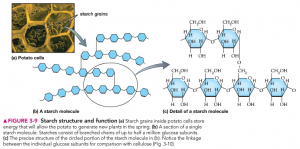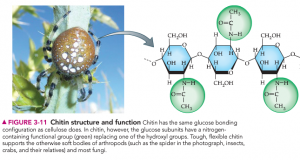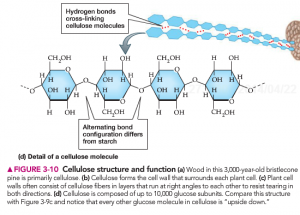Classification of Carbohydrates
Carbohydrates
Carbohydrates are the major source of food and the major form of energy for most living organisms. When individual carbohydrate molecules combine together to form larger structures (or polymers) they can also serve as long term food storage (i.e. starch), as protective coverings (i.e. chitin) and as the main structural support for plants (i.e. cellulose).
Starch

Chitin

Cellulose

Carbohydrates
As described in your textbook, the term ‘carbohydrate‘ literally means ‘carbon plus water’. Therefore, carbohydrate molecules are composed entirely of carbon, hydrogen and oxygen atoms, typically in a ratio of (1) carbon atom : (2) hydrogen atoms : (1) oxygen atom. Recall that the carbohydrate glucose has the chemical formula C6H12O6 and therefore is consistent with this ratio. In most instances, carbohydrates exist in the form of small, water-soluble sugars which can be combined together to form larger molecules or longer chains of molecules.
Monosaccharides and Discaccharides
The term ‘saccharide’ is derived from the Greek word ‘sakkharon’ which means ‘sugar’ (not to be confused with the artificial sweetener ‘saccharin’!). A monosaccharide refers to a single sugar molecule while a disaccharide refers to when two monosaccharide molecules are linked together via a covalent bond, such as is the case with the disaccharide sucrose, aka ‘table sugar’ (shown below). Both mono- and di-saccharides are referred to as ‘simple sugars’.
Monosaccharide |
Disaccharide |
 |
 |
| Glucose | Sucrose |
Polysaccharides
Polysaccharides, as their name implies, are complex sugars comprised of many monosaccharide molecules linked together. These larger molecules are typically insoluble in water at room/body temperature and provide cells with the ability to store energy, as is the case with the molecule starch. Another key function of polysaccharides is structural. For example, the ‘crunch’ of celery is due to the presence of cellulose, a large polysaccharide found only in plants, within the outer walls of the plant’s cells.
In the images below, you can see how the individual monosaccharide molecules are linked together to form branched (starch) and unbranched (cellulose) polysaccharides.
Starch |
|
Cellulose |
 |
Biomolecule Structure
In the activity below, drag the appropriate biomolecule label on the right to label each structure correctly. When all labels have been placed correctly, you will be notified. To reset the activity, click the ‘reset’ button. (Note: you will see this activity several times as you work through this module; you will be able to practice as many times as necessary until you get all of the labels placed correctly)
From http://www.ontrack-media.net/biology/bm1l1drag2.html
Carbohydrates
Carbohydrates are a family of biomolecules that include sugars, starches, cellulose, and chitin.
Sugars include monosaccharides (such as glucose) and disaccharides (such as sucrose). They are used for temporary energy storage and the construction of larger biomolecules, including complex carbohydrates.
Starches (found in plants) and glycogen (found in animals) are polysaccharides which provide long-term energy storage.
Cellulose forms the cell walls of plants and provides rigidity and structure. Similarly, chitin strengthens the exoskeletons of many invertebrates.